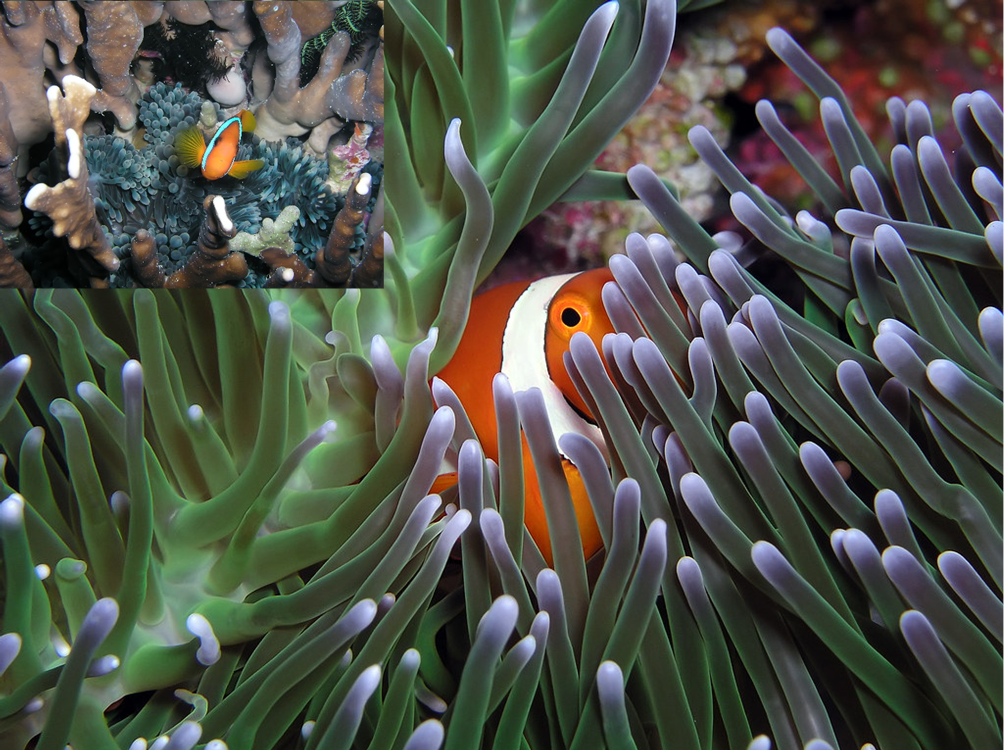
By Stefania Papa
The clownfish, which became famous thanks to the film “Finding Nemo”, is one of the favourite models of photographers. They are small, easy to find, charismatic fish that often seem to play hide and seek among the anemone’s tentacles. But this is much more than a game …
Clownfish and anemones live in perfect symbiosis and have a relationship beneficial to both. For most fish, the anemone’s tentacles are poisonous because they contain nematocysts. Nematocysts are harpoon-like stingers on the anemone’s tentacles used to capture prey and ward off predators. The anemone is a predator that, attached to a rock, waits for unsuspecting prey to arrive at the right distance to attack it, paralyzing it with its quill.
When choosing a sea anemone, the clownfish performs a very particular dance with this marine animal: it gently rubs itself on the tentacles with different parts of the body in order to accustom it to its presence.
Once it has chosen its home, this curious fish supplies the anemones with nutrients through its fecal matter and keeps them protected from butterfly fish, which usually feed on their tentacles (Verde et al., 2015).
The sea anemone feeds on fish. However, the mucus layer that covers the clownfish’s skin offers protection that makes them immune to its lethal sting. The mucus layer is three to four times thicker than that of other fish, and can be a combination of both anemone and clownfish mucus. The clownfish is born with a mucus layer that is already thicker than average, but as it grows, it can mix its mucus with that of the anemone’s to create a stronger barrier (Roux et al., 2019).
In order to live among the anemone, clownfish first and foremost protect themselves from nematocyst strikes. While most fish try to eat the nutrient-rich tentacles, the possibility of being stung while eating deters the clownfish from nibbling on it. In return, the anemone has evolved to not strike the clownfish.
Clownfish benefit from their symbiosis with anemones as they are protected from predators by the presence of the stinging tentacles and forage for their food with the leftovers of the anemones.
What is the benefit of this symbiosis with the clownfish for anemones? The former acts as bait, with the consequence that predators trying to attack the clownfish are stung and become food for the anemone. The clownfish also eats dead tentacles, thus keeping the surrounding environment clean. The graceful movements that the clownfish perform for photographers are a benefit for the anemone as they increase the flow of water and therefore the oxygen that helps the anemone to breathe (Szczebak et al., 2013).
While the relationship of clownfish and sea anemone is not an addictive relationship, their lives are much easier when they are together.
The relationship of trust and help between these two species is so powerful that the clownfish lays its eggs at the base of the anemone’s tentacles.
References
Roux, N., Lami, R., Salis, P. et al. Sea anemone and clownfish microbiota diversity and variation during the initial steps of symbiosis. Sci Rep 9, 19491 (2019)
Verde, A., Cleveland, A. & Lee, R. W. Nutritional exchange in a tropical tripartite symbiosis II: direct evidence for the transfer of nutrients from host anemone and zooxanthellae to anemonefish. Mar. Biol. 162, 2409–2429 (2015)
Szczebak, J. T., Henry, R. P., Al-Horani, F. A. & Chadwick, N. E. Anemonefish oxygenate their anemone hosts at night. J. Exp. Biol. 216, 1350–1350 (2013)
Stefania Papa is an associate professor in Ecology at the University of Campania “Luigi Vanvitelli” in Caserta-Italy.